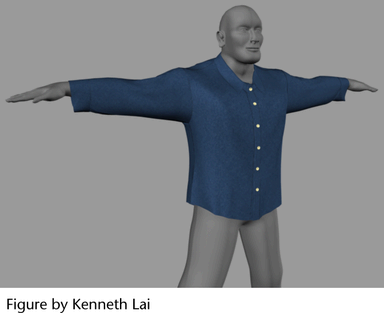
You can use nConstraints to adjust the behavior of nCloth, nParticle, and nHair objects, by restricting their movement or securing them to other objects. For example, sometimes you may want to constrain certain parts of your nCloth clothing to your character so that it doesn’t fall off. You can use constraints to make sure the pants of your character stay on, or keep the straps of a dress attached to the shoulders of your character. You can also use constraints to shape nHair into pony-tails or other styles. With nParticles, you may want to constrain nParticles to an nCloth object, and adjust the constraint strength so that the particles fly off the nCloth when it collides with another Nucleus object.
All nConstraints are supported by nCloth objects, however, not all nConstraints are applicable to nParticles and nHair objects. nParticle and nHair objects support the following nConstraints:
For more information on nConstraints and how to use them, see:
Transform constraints hold selected vertices of nCloth and passive collision objects, nHair curve CVs, and selected particles of nParticle objects in place or move them through XYZ space. Transform constraints have transform constraint locators that control the constrained vertices or particles. This locator can be parented, animated, or constrained to another object. For example, you can animate the transform constraint locator of a Transform constrained nCloth silk scarf to direct its movements as it falls through the air.
Component to Component constraint
Component to Component constraints attach nCloth components (vertices, edges, or faces), nHair curve CVs, and nParticle components (individual particles) to other nCloth, nParticle, nHair or passive object components. For example, you can use a Component to Component constraint to attach a button to an nCloth shirt.
Point to Surface constraints attach nCloth components (vertices, edges, or faces), nHair curve CVs, and nParticle components (individual particles) to a target surface (an nCloth surface, or a passive collision object). This type of nConstraint is useful when you want to hold parts of an nCloth object (like a cuff on a shirt) to a polygon mesh (like a character’s wrist).
Slide on Surface constraints attach nCloth components (vertices, edges, or faces), nHair curve CVs, and nParticle components (individual particles) to a target surface (another nCloth surface, or a passive collision object), and allows the constrained components to move or slip along the surface to which they are constrained. The Slide on Surface constraint is a variation of the Point to Surface constraint that allows sliding. This type of nConstraint can be used instead of collisions, and in most cases works faster than collisions.
Weld Adjacent Borders constraint
Weld Adjacent Borders constraints snap and merge the nearest borders of selected nCloth objects. This type of nConstraint is useful when you want separate nCloth meshes to behave as if they are a single nCloth object. nParticle objects do not support Weld Adjacent Borders constraints.
Force Field constraints push nCloth, nHair curve, and nParticle components or objects away from the center of the constraint with a radial field with spherical volume bounds. When you create a Force Field constraint a force field locator appears in the scene. The size, shape, and location of the locator denotes the size, shape and location of the force field.
You can use a Force Field constraint to correct unwanted penetrations by repelling objects or particular vertices, nHair curve CVs, or nParticles. For example, you can push out nCloth that gets stuck within the elbow joint of a character by placing a Force Field constraint on the joint. Conversely, you can use it to suck in or contain nCloth within the bounds of the constraint.
A Force Field constraint can be applied to the whole Nucleus object, as well as to localized vertices, curve CVs or individual nParticles. Use the Force, Strength and Strength Dropoff attributes on the dynamicConstraint node to determine the power of the force field. Positive values cause the force field to push out, while negative values cause the force field to suck in the nCloth, nHair or nParticles.
Attract to Matching Mesh constraint
Attract to Matching Mesh constraints attract the vertices of an nCloth object to the corresponding vertices of a passive object with matching topology. This type of constraint is useful when you want your nCloth to assume a specific shape during simulation.
For example, use this constraint to create a specific end shape for a garment falling off of a character that must land in a specific shape, or orientation in the scene. The Strength attribute on the dynamicConstraint node determines how closely your nCloth object resembles your target mesh. nParticle objects do not support Attract to Matching Mesh constraints.
Tearable Surface constraints make nCloth objects tearable or shatterable by separating all of their faces, generating new edges and vertices, merging the nCloths’ vertices, softening the nCloths’ edges, and constraining the nCloths’ points (tear) or edges (shatter) together using the Weld constraint method. This is useful when you want to create nCloth surfaces that can rip or shatter when they collide with passive objects or other nCloth objects. The Glue Strength attribute on the dynamicConstraint node determines how easily an nCloth tears or shatters. nParticle objects do not support Tearable Surface constraints.
Disable Collision and Exclude Collision Pairs constraints
Disable Collision and Exclude Collision Pairs constraints restrict how nCloth, nParticle, and passive object components collide. The Disable Collision constraint prevents its members from colliding with all other Nucleus objects or nCloth and nParticle object components. The Exclude Collide Pairs constraint prevents its members from colliding with specific Nucleus objects, or nCloth and nParticle object components. These constraints are useful when you want to improve the performance of your nCloth or nParticle objects, when you want to control which regions of your nCloth or which particles collide, or when you want to avoid trapping cloth inside collision geometry.